When it comes to leopard gecko care, or caring for any pet for that matter, things can get quite complicated. It can be hard to find useful information and information overload is another thing that often complicates things… Luckily, you have this leopard gecko care guide!
In this leopard gecko care guide, I’m going to cover everything you need to know about how to care for a leopard gecko. Caring for your leopard gecko isn’t hard when you know what to do!
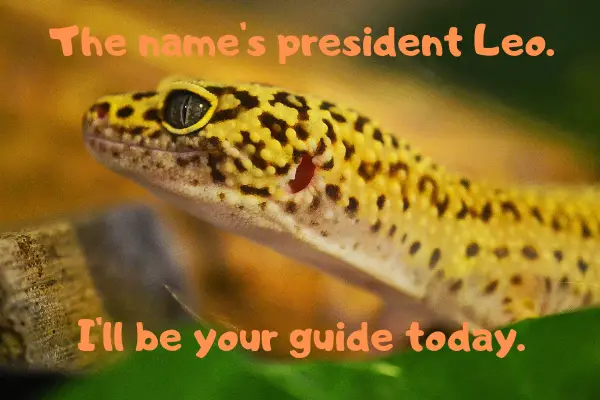
In this care guide, we’re going to cover each topic step by step. The topics we’re going to cover are:
- Leopard gecko care sheet – overview
- How are leopard gecko’s as pets
- Housing
- Diet
- Selecting your new leo
- Shedding
- Common problems
- Tips, tricks and conclusion
We have already covered each of these topics separately and will make sure to link you through to those articles as well, throughout this care guide.
At the start of this leopard gecko care guide, we’ve added a care sheet. It’s still worth reading the whole article, but this care sheet is a helpful place to keep coming back to if you’re ever lost. This saves you reading through the entire care guide every time you have a question.
If there’s something you can’t find, then you can use the clickable menu to scroll straight to the right section.
Also, if there’s something you feel I’ve missed in this leopard gecko care guide, then please leave it in the comments or send me a message. I’m always looking to improve this site, and any help is much appreciated.
Table of Contents
The leopard gecko care sheet:
Housing:
- Leopard geckos need a terrarium that’s at least 10 to 20 gallons
- It’s best to get a terrarium that opens from the side
- Reptile carpet or paper towels are some of the best substrates for leopard gecko’s
- Clean the enclosure regularly
- Heat the enclosure using a heat mat. NEVER use a heat rock!
- Only heat about 20-30% of the terrarium to provide a good temperature gradient
- Keep the temperature around 73-80 degrees Fahrenheit on the cold side (22-26 degrees Celsius) and 85-93 degrees Fahrenheit on the warm side (29-33 degree Celsius).
Diet:
- Feed your leopard gecko
gutloaded crickets and mealworms - You can also feed wax worms and super worms as treats every now and again
- Feed juveniles 4 times a week and adults about 3 times per week
- Coat insects in supplement regularly to ensure they get the right nutrients
Selecting your new Leo:
- Look to see if the leopard gecko is well fed and has no missing digits or limbs
- Check to see if the jaw is closed and has a normal shaped
- Look at the state of the enclosure as well as the state of other animal enclosures to check how to breeder cares for their animals
Shedding:
- Moisten your leopard gecko’s hides when you notice they are about to start shedding
- Make sure to feed them well during the month. Leopard geckos may lose their appatite when they start to shed
- Your can help your leopard gecko shed if you really need to. See our leopard gecko shedding guide for more information on this topic
Common problems:
- For any large problems, go and see the vet so they can look at it.
What are leopard geckos like as pets?
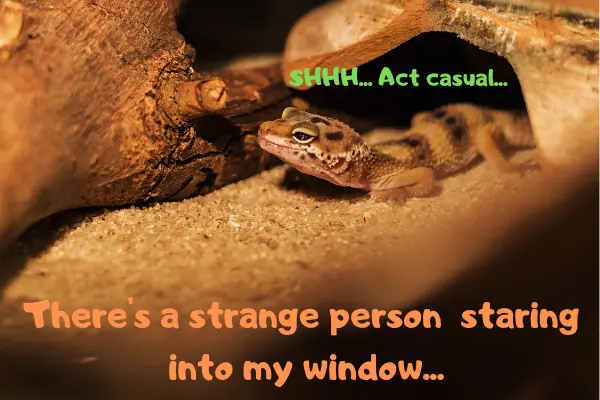
Leopard gecko’s make great pets. They originate in areas around India, Pakistan and Afghanistan and have a calm demeanour.
They’re a delight to care for and don’t have many special requirements. This makes them a great pet reptile for beginners! On top of this, they are very hardy too and don’t have health problems very often.
Leopard geckos can reach 10-15 years old and, in some cases, even well into the twenties. This means that you’ll be caring for them for quite some time to come.
Anatomy
Leopard gecko’s have some unusual features when it comes to their anatomy. The first is that leopard geckos can actually drop their tail!
This means that, if a predator grabs their tail in the wild, it can detatch. The tail then keeps wriggling for a little while, giving the gecko enough time to escape. The tail then grows back over time.
Also, they aren’t like most geckos. Leopard geckos don’t possess the ability to stick to vertical surfaces. Actually, they have claws like many other lizards do.
Leopard geckos aren’t very expensive pets to own. Their food is cheap and you can even breed it yourself!
There are a lot of breeders and prices aren’t very high for the normal varieties. The only thing you should keep in mind is that the constant heating of the enclosure will add some money onto t
Handling
Leopard geckos aren’t the best species to be handled. They are more of a display lizard but can be handled for short periods of time. When you do need to handle them, they’re very easy to handle once they’re used to it.
It’s good to get your leopard gecko used to being handled because it may be necessary in the future. If they are used to you it’s much easier to help out with shedding or taking them out of their enclosure when you go to clean it.
All in all, leopard geckos make great pets and are a wonderful addition to your home!
Housing
Obviously, no leopard gecko care guide is complete without covering housing!
Since they live around India, Pakistan and Afghanistan, leopard geckos are used to rocky and warm environments.
In the wild, a leopard geckos’ habitat is rocky and warm. They live in areas around India and Afghanistan in the wild, and it’s our job as reptile keepers to give them a good environment to live in.
First… Size!
A leopard gecko enclosure should be a minimum of 10 – 20 gallons and should be wider than it is high. Because leopard geckos lack the ability to climb flat surfaces like other geckos, they need a lot more space on the ground than other geckos.
If you decide to go with heat lamps, then an enclosure that’s larger than this is necessary. They need the space to be able to regulate their body temperature as the lamp will heat up the air more than
A larger enclosure also offers your gecko more space to explore.
Picking the right terrarium
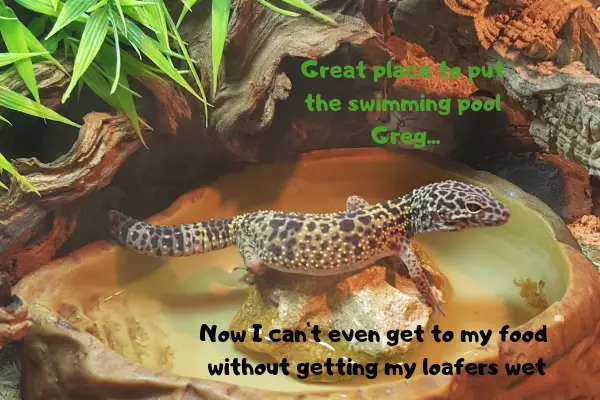
Not only does the terrarium need to be large enough, but it’s best if the terrarium opens from the side. This is because it will give you easier access to the different area’s you need to get to.
Also, coming from the side seems less threatening to your leopard gecko than moving towards it from the top.
You also need to think about the strength of your terrarium. If it’s not strong enough to hold the substrate and other items you will plac into it, get one that’s stronger.
There’s nothing worse than the bottom of your terrarium falling out when lifting it!
It’s also dangerous for your Leo, too.
Substrate
When it comes to substrate, there are arguments on each side. Some people prefer sand, others use paper towels or newspapers while others use reptile carpet.
Sand:
Calci/reptile-sand isn’t ideal for leopard geckos. It’s commonly used and can be used safely, but it’s often not worth the extra effort.
The downside to sand is that it can damage your gecko if it consumes too much. This can happen when they accidently consume it whole feeding.
Should you go with sand, which isn’t advised, you can prevent your gecko from eating the sand by ensuring you feed them in feeding dishes and by providing them with enough supplement.
Really, sand isn’t ideal for your leopard gecko and it’s best to go with the other options…
Note: Don’t keep very young leopard geckos on sand as they are less resilient than the older ones.
Reptile carpet:
Reptile carpet is great because it provides the best of both worlds. It looks more natural than paper towels or newspapers but doesn’t have any loose material like sand.
Ensure you add a new reptile carpet in regularly to prevent it getting damaged. If it does get damaged, or you go with the wrong type of reptile carpet, your leopard geckos little toes could get stuck to it.
This can cause problems so make sure to keep an eye on it. That being said, reptile carpet is a great option and is the best option if you want a natural look.
Paper towels/newspaper:
This option is great for cleaning and it’s an easy substrate to keep your leopard gecko on. The only real issue is that it looks horrendous and isn’t natural what so ever.
A lot of people have problems with this from both the aesthetic side, as well as the moral side. If your
Leopard geckos seem to take well to paper towel and newspaper and I’ve never heard reports that they don’t like paper towels or newspaper or get stressed on it.
Cleaning!
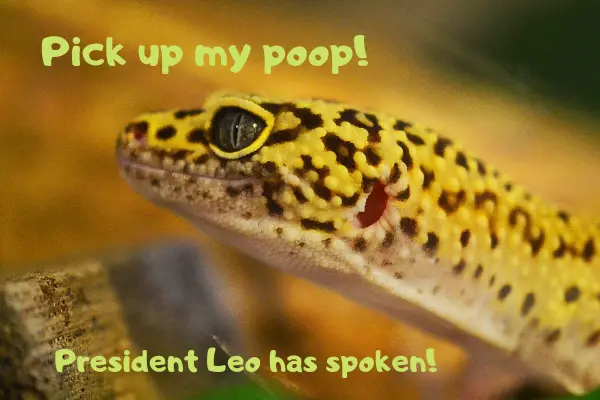
Depending on the type of substrate you use, you will need to clean the enclosure more or less often. If your leopard gecko is living on sand, then scooping out the sand regularly and cleaning every 2-4 weeks should work fine.
Always remove faecal matter from the water dish and clean it out thoroughly when you notice it. The same goes for any dead insects you may find in there. Fresh water should be provided every day.
On paper towels and reptile carpet, more regular cleaning is needed. You should always remove feces and dead insects when you see them On top of that, you should refresh the paper towels (or was the reptile carpet) once or twice per week.
Hides
It’s important to provide your leopard gecko with enough opportunity to hide. You should give your leo multiple hides so that he can choose which one suite him the best. This also makes it easier for him to thermoregulate.
Since they spend most of the day in rocky crevice’s, and only come out to hunt in the morning and night, they will usually spend a lot of time in their hides.
Be very careful that the hide you choose can’t topple over or cause any damage. The same is true for anything else you may want to add to the terrarium.
If you decide to add rocks or pieces of wood, ensure that these are fastened well, or at least won’t fall. Your gecko won’t double check for you!
Always ensure everything is thoroughly cleaned before you place it into your Leo’s enclosure. This prevents outside contaminants from entering the terrarium. Also, make sure that there aren’t any sharp edges and that any wood added doesn’t splinter.
There are certain plants that you can add, but it’s probably best to stick to fake ones when you first get your gecko.
I’ll make sure to expand this leopard gecko car guide later on in the year in order to cover more specific topics like this!
Heating, temperature and humidity
Leoaprd geckos obviously need heating in their terrarium. As with all reptiles, they are cold blooded and rely on external heat sources to regulate their body temperature.
When it comes to heating, leopard geckos aren’t very hard. Briefly stated, they need about 20-30% of the terrarium to be heated, and the rest to be cooled.
Leopard geckos absorb heat through their belly, so they need a hot surface to lie on. This helps them digest their food.
Personally, I’d advise you to use a heat mat to heat your gecko’s enclosure. This provides a regulated hot surface, without heating the air to an extreme extent.
When using a heat mat, ensure you place the heat mat underneath the glass. Also, ensure that there is some air between the heat mat and the tank. This will prevent damage to the glass as well as preventing the heat mat from overheating.
On top of this, make sure you don’t add too much substrate on top of the heat mat. Adding too much substrate will prevent the top layer of substrate from heating up.
Heat lamps
Heat lamps aren’t really ideal for leopard geckos. Leopard geckos don’t usually bask and since they need the heat coming from underneath them, a heat lamp can be a challenge.
If you do use a heat lamp, it’s best to place it above a rock or some other kind of surface that will heat up. This enables your gecko to use it to heat up its underbelly.
The problem with heat lamps
If you do go with lights, ensure your enclosure is well ventilated. If not, the air temperature can get very high. Also, make sure you get an enclosure that’s relatively large so they can still thermoregulate properly.
Overal, heat lamps are going to set you back more than a heat mat and aren’t the best option. Bare in mind, this is based on my experience and opinion!
Heat rocks also exit… That’s enough said about that. Not ideal, probably don’t use them unless you are very sure they won’t burn your gecko. Even then ensure another form of heating anyway.
The ideal temperature for your gecko is around 73-80 degrees Fahrenheit on the cold side (22-26 degrees Celsius) and 85-93 degrees Fahrenheit on the warm side (29-33 degree Celsius).
You can measure the temperature using a thermometer, and if you use a heat mat you should ensure it is set to the right temperature!
Diet
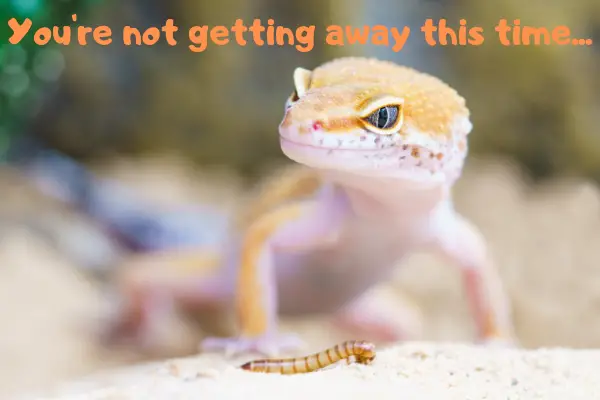
When it comes to diet, leopard gecko’s only eat insects. You should feed your leopard gecko mainly mealworms and crickets.
Wax worms and super worms can be given to your gecko every once in a while as a treat, or when they need to pack on the pounds. These are great for adding to your geckos weight if it’s underweight, but not a staple food.
You always need to gut load your feeder insects. This pretty much just means feeding the insects well before they are fed to your leopard gecko.
Size wise, the insects you give to your leopard gecko should always fit in their mouth. A max of 2/3 of their head size is often used as a guideline, but this can be inaccurate. Mealworms for example, are a lot longer than they are wide.
If you try to feed too large crickets to your leopard gecko, they just won’t eat them.
It’s often best to feed your leopard gecko in a feeding dish. This will prevent the meal worms from crawling, digging and hiding in the enclosure. When it comes to crickets, there’s not much you can do.
Crickets are great as you can see your leopard gecko hunting them. This also gives them something to do…
Another reason to use a feeding dish is so that the supplement you provide your leopard gecko with stays on the insects better. It’s important for your leopard gecko to ingest this supplement to ensure they get all of their needed vitamins and minerals.
How much to feed
Really, it’s best to experiment a little with this and keep an eye on their weight. There’s no one-size-fits-all when it comes to the amount you should feed your leopard gecko.
Once it is full, it will stop eating and usually not need food for a few days after that.
When they are young you can feed them about 4 times per week since they are still growing. As they get older, 2-3 times per week is enough.
If it hasn’t eaten all of its crickets, you can leave them in there for a little while. Make sure you keep an eye on the crickets in the enclosure. Crickets can have the tendency to pester leopard geckos. Some cricket species can even nip at your gecko!
Leopard geckos store a lot of fat in their tail, so they can go quite some time without food. It’s best to feed them regularly though and to keep an eye on their weight.
Supplements
Leopard geckos main supplement is calcium. It can also benefit from a mix of some other vitamins and minerals too though!
I’ll link to a few good supplements underneath this section asap so you get a rough idea of what to look for.
These supplements are sold in most pet stores, and you can always get yourself a good supplement for leopard geckos online.
To make sure your gecko ingests enough of the supplement, you can coat your insects in it. You also have the possibility of providing a small, shallow dish of supplement in your geckos enclosure. They will periodically “bulk up” on the supplement when they need it.
Even though you can add a dish, it’s still best practice to coat the feeder insects regularly to make sure they are consuming enough of the supplement.
Shedding
Leopard geckos shed roughly once per month. Some shed more often and some less. As your gecko gets older, it tends to shed less as it’s not growing anymore.
When it comes to leopard gecko care, one of the worst parts is shedding. It’s more of a nuance than anything else, as it can require you to put in some work too in some cases.
Leopard geckos shed their skin to be able to grow, but also for normal regeneration purposes. Us humans shed our skin too in millions of tiny pieces. They just don’t mess about and do it all in one go!
Shedding can tell you a lot about the health of your leopard gecko, and problems with shedding can indicate real issues.
For example if your leopard gecko is failing to shed (you can tell due to the coloration and it not having shed in a while), this can indicate health problems or problems in the environment.
To ensure a good shed, always make sure that your leopard gecko is in a safe living environment. Make sure it’s free of parasites and it’s kept clean.
Remove any fecal matter and dead insects, clean the water dish etc etc…
Another important factor when it comes to shedding is diet!
You need to make sure that your leopard gecko is eating well and that they are getting enough supplementation.
You can even choose to add a shallow dish of the supplement to the terrarium before shedding time to make sure he’s ready for the big day.
One other thing you can do to make the shedding process a lot easier for your leo, is to moisten a hide when you notice he’s getting close to shedding.
You can use peat moss to ensure the humidity in the hide stays constant. Your leo will often choose this hide as it makes shedding a whole lot easier.
These are the three main things you should do to ensure a good shed. Keep your leopard gecko healthy and moisten the hide when the big day arrives and you should be all good in most cases.
However, sometimes your leo is going to need some help with the shedding. Sometimes pieced of shed skin stay attached on your gecko.
Visit our guide to leopard gecko shedding for more information about this!
We’ll cover the basics here…
If this happens, the first thing you should do is moisten the shed skin that’s still attached. Doing this will make it come off easier.
After that, you can use cotton buds or your hand to gently pry it loose. Make sure not to pull or rip it off as the skin may not be properly shed yet.
While doing this, just be patient and the skin will come off over time.
It’s important to remove this shed skin as it can cause infections if it isn’t removed.
Common problems
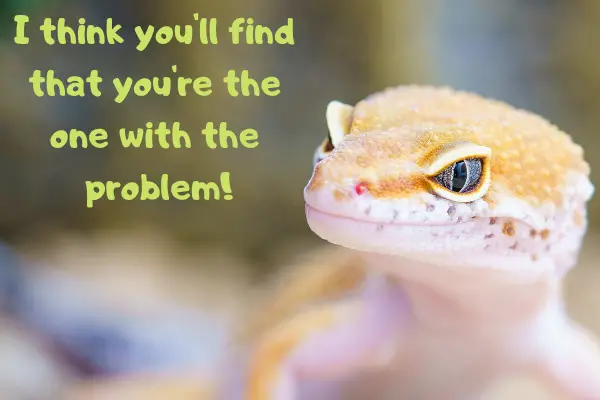
A leopard gecko care guide wouldn’t be complete without a section listing the most common health problems.
It must be said that if you do come across these things on your Leo, it’s best to visit the vet who can help you deal with it. There are special vets that are specialized in reptiles which will definitely help you out!
Metabolic bone disease
Leopard gecko’s aren’t as prone to this as bearded dragons, but there’s still a risk. You can prevent this by properly gutloading the insects you feed your LEO, as well as dusting the feeder insects regularly. Some signs include:
Lathargy and weakness- A crooked or “rubbery jaw
- Painful movement
Swolen limbs
Visit a vet if you see these signs in your leopard gecko.
Digestive issues
Digestive issues can causmany different problems in leopard geckos. If you come across any of these signs, it’s best to consult with a vet.
- Rapid weight-loss
- Watery stool (stool should be hard with a small white tip)
- Bloody stool
- Undigested food items in the stool
Mouthrot
Mouthrot needs to be dealt with fast. Visit the vet if you see any of the following symptoms:
- Uneven upper and lower jaw
- Cysts or puss around the mouth
- failure to eat properly
As well as these, there are other things that can cause harm or illness to your leopard gecko. Make sure to check them and weigh them somewhat regularly and do your best to supply a clean living environment and a healthy diet.
Generally, leopard geckos are very hardy lizards, so the chances of you encountering these probkems is relatively low, but can happen.
Conclusion
As you can see, leopard gecko care is quite easy once you know what to do. Caring for leoaprd geckos is very rewarding, and Leo’s are a great pet to have!
